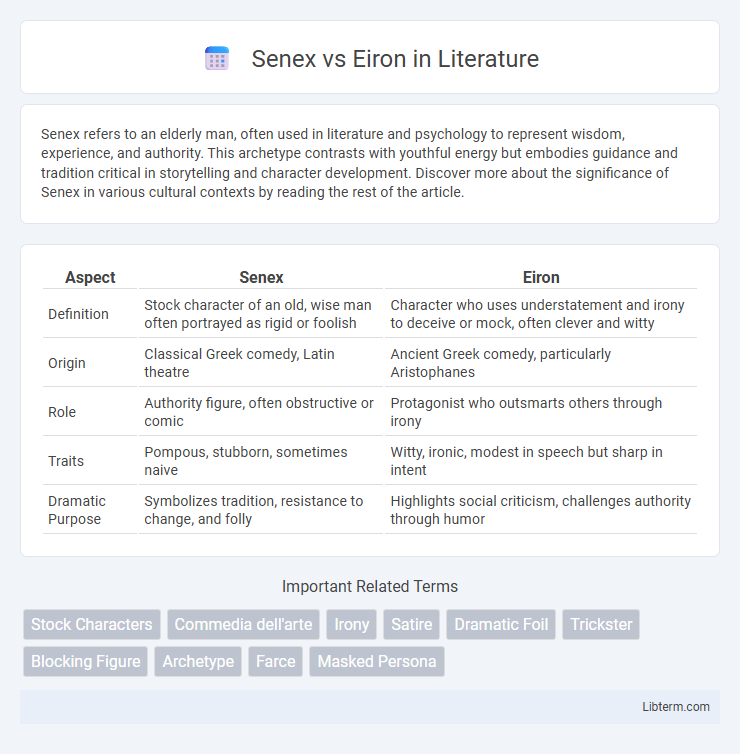Senex refers to an elderly man, often used in literature and psychology to represent wisdom, experience, and authority. This archetype contrasts with youthful energy but embodies guidance and tradition critical in storytelling and character development. Discover more about the significance of Senex in various cultural contexts by reading the rest of the article.
Table of Comparison
| Aspect | Senex | Eiron |
|---|---|---|
| Definition | Stock character of an old, wise man often portrayed as rigid or foolish | Character who uses understatement and irony to deceive or mock, often clever and witty |
| Origin | Classical Greek comedy, Latin theatre | Ancient Greek comedy, particularly Aristophanes |
| Role | Authority figure, often obstructive or comic | Protagonist who outsmarts others through irony |
| Traits | Pompous, stubborn, sometimes naive | Witty, ironic, modest in speech but sharp in intent |
| Dramatic Purpose | Symbolizes tradition, resistance to change, and folly | Highlights social criticism, challenges authority through humor |
Understanding Senex and Eiron: Archetype Definitions
Senex and Eiron represent two contrasting archetypes in literature and psychology, where Senex embodies wisdom, authority, and tradition, often characterized by a stern and guiding figure. Eiron symbolizes the clever underdog or self-deprecating trickster who uses wit and irony to challenge authority and disrupt expectations. Understanding these archetypes elucidates their roles in narratives as embodiments of order versus subversion, providing insight into character dynamics and thematic development.
Historical Origins of Senex and Eiron
The Senex, rooted in ancient Greek theater, represents the archetype of the wise old man, often embodying authority, experience, and conservatism in comedic and tragic plays. Originating from Greek New Comedy, the Senex figure typically serves as a foil to younger characters, highlighting generational conflicts through his rigidity and sometimes foolish adherence to tradition. In contrast, the Eiron emerges from Old Comedy as a crafty underdog who uses understatement and wit to outsmart opponents, embodying a clever and resourceful character opposite the boastful Alazon.
Characteristics of the Senex Archetype
The Senex archetype embodies wisdom, discipline, and a deep sense of responsibility, often manifesting as a mentor or authority figure who values order and tradition. This archetype is characterized by a structured mindset, prudence, and a cautious approach to change, contrasting with the playful, deceptive nature of the Eiron. Senex figures emphasize stability, long-term planning, and the preservation of established knowledge, serving as guardians of societal norms and ethical standards.
Traits and Role of the Eiron Archetype
The Eiron archetype in literature embodies wit, irony, and subtle humor, often using self-deprecation and clever understatement to challenge authority or reveal deeper truths, contrasting with the Senex's rigid wisdom and solemnity. This trickster figure operates through ambiguity and playful deception, fostering critical thinking and disrupting conventional wisdom. The Eiron's role centers on subverting expectations and encouraging adaptability, making it essential for dynamic character development and thematic complexity.
Senex vs Eiron: Key Differences
Senex and Eiron are contrasting character archetypes in classical literature, with Senex representing the old, authoritative figure often characterized by rigidity and stubbornness. Eiron, on the other hand, is defined by their use of subtle irony and self-deprecation to undermine opponents or societal norms. The key differences lie in the Senex's overt dominance and conservatism versus the Eiron's indirect, clever subversion.
Archetypes in Classical Literature
Senex and Eiron represent contrasting archetypes in classical literature, embodying different aspects of wisdom and deceit. The Senex archetype is characterized as a wise old man, often embodying authority, experience, and moral guidance, exemplified by characters like King Lear or Nestor. In opposition, the Eiron archetype features a character who uses irony, understatement, and disguise to outwit others, such as Odysseus in Homer's epics, illustrating cunning over straightforward wisdom.
Modern Interpretations of Senex and Eiron
Modern interpretations of Senex emphasize his role as a symbol of wisdom, experience, and authority in literature and psychology, often embodying the archetype of the wise old man. In contrast, the Eiron represents humility, cleverness, and self-deprecation, serving as a foil to the Senex's rigidity and dogmatism. Contemporary analysis explores how the tension between Senex and Eiron reflects societal attitudes toward aging, knowledge, and power dynamics in storytelling and character development.
The Psychological Significance of Senex and Eiron
The psychological significance of Senex lies in its embodiment of wisdom, discipline, and authority, often representing the cautious and structured aspects of the psyche associated with maturity and experience. In contrast, the Eiron symbolizes humility, cleverness, and self-deprecation, playing a crucial role in subverting arrogance and encouraging adaptability through wit and irony. Together, these archetypes reflect the dynamic interplay between order and flexibility, influencing personal growth and social interactions by balancing seriousness with humor.
Senex and Eiron in Popular Culture
Senex and Eiron are stock characters rooted in ancient Greek comedy, with Senex representing the old man, often stubborn or authoritative, and Eiron portraying a self-deprecating figure who uses understatement to outwit opponents. In popular culture, Senex appears frequently as the archetypal grumpy elder in sitcoms and literature, embodying resistance to change and traditional values, while Eiron inspires characters who employ wit and irony to subvert social norms or authority. Their dynamic influences modern storytelling tropes, reinforcing themes of generational conflict and cleverness prevailing over brute force.
The Lasting Impact of Senex and Eiron Archetypes
The enduring influence of the Senex and Eiron archetypes shapes character dynamics in literature and psychology by embodying wisdom and strategic wit, respectively. Senex, the archetype of the wise elder, represents experience, authority, and stability, often guiding narratives through moral insight and restraint. The Eiron archetype, characterized by irony and humility, challenges conventions and reveals deeper truths, fostering growth and transformation within stories and real-life social interactions.
Senex Infographic

 libterm.com
libterm.com